
Reflections from the first phase of activities at schools in Madhesh Province
April 4, 2025 Team Reflections OLE Nepal
In February 2025, our project team visited two of the project locations under the ONGD-LLEST Project: Janakpurdham Sub-Metropolitan City and Dhangadhimai Municipality. With two teams of five members each, we visited Shree Madhyamik Vidyalaya in Janakpurdham-22, Basabitti, and Shree Janta Adharbhut Vidhyalaya in Dhangadhimai-4, Shantanagar. The visits focused on setting up an offline server with O.L.E. Nepal's digital learning resources, providing tablets to access those learning materials, and introducing students and teachers to our learning platforms. Beyond that, we worked to build rapport with schools and local communities, assess learning needs, test the usability of the learning platform, gather feedback through teacher and student surveys, and lay the foundation for long-term collaboration in enhancing education.
As part of our field activities, we conducted orientation sessions at both schools to introduce key stakeholders to the digital resources and the objectives of the project. These sessions served to engage school administrators, teachers, parents, guardians, local representatives and School Management Committee (SMC) members in discussions on digital learning and its integration into classrooms. The orientation also featured hands-on activities where participants explored E-Paath, E-Pustakalaya, and Hamro Ramailo Kathaharu (HRK) videos using tablets. Additionally, we demonstrated the setup and functionality of the offline server and Wi-Fi router, allowing them to experience the resources firsthand on both mobile devices and tablets. The session further outlined the planned field activities, including teacher and student surveys, training sessions, and needs assessment workshops. Participants responded positively to the sessions, expressing enthusiasm for the learning tools and the structured digital environment designed to enhance students’ educational experiences. These sessions helped in familiarizing educators and community members with digital learning tools, addressing their concerns, and laying the groundwork for further technology integration in the classroom.
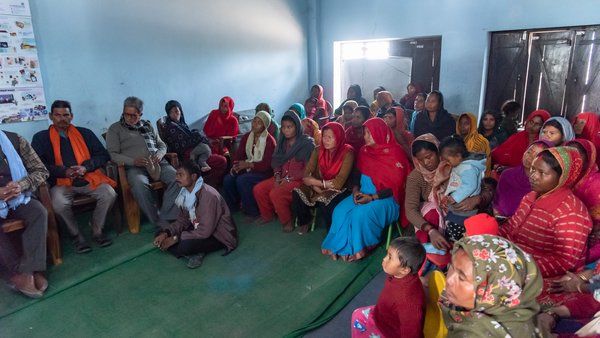
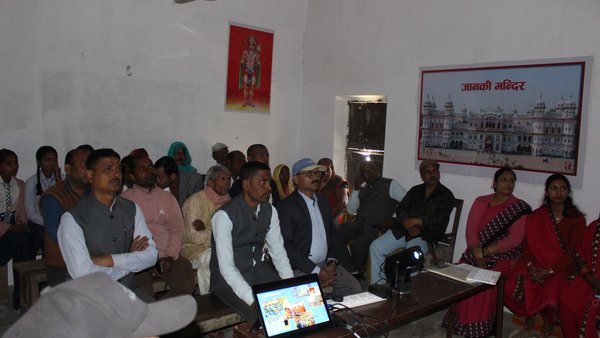
The teachers' FGDs conducted at both the schools provided insights into their teaching experiences, curriculum relevance, student aspirations, and technology integration. Teachers highlighted the evolution of education, shifting from traditional methods to digital tools while emphasizing the need for localized content and skills-based learning. Challenges such as resource limitations, subject-specific teacher shortages, and digital literacy gaps were common concerns. Teachers recognized technology's potential to enhance learning but stressed the need for training and infrastructural support. Discussions also revealed the growing influence of family decisions on students’ career choices, the importance of extracurricular activities, and gaps in life skills education. Despite challenges, teachers demonstrated strong commitment to student success, adaptability to new methods, and enthusiasm for integrating digital tools into classrooms.
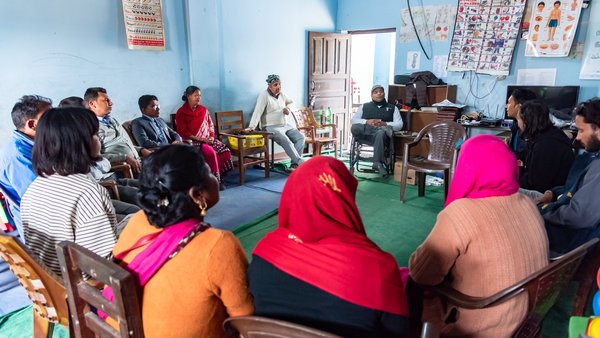
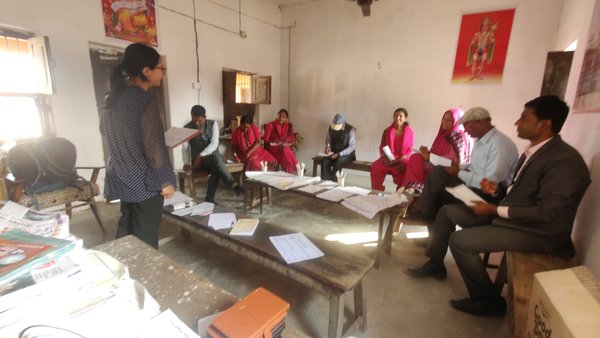
As part of our ongoing efforts to enhance digital education and understand the teaching landscape, we also conducted teacher surveys using an in-house-built survey application. This enabled us to gather insights into teachers' backgrounds, teaching practices, media consumption habits, and their use of digital technology in classrooms. A total of 20 teachers, 10 from Shree Madhyamik Vidyalaya in Janakpurdham and 10 from Shree Janta Adharbhut Vidhyalaya in Dhangadhimai participated in the survey. Through the survey, we found out that while mobile and social media usage is widespread among teachers, there remains room to strengthen skills to support more effective integration of educational technology in classrooms. Teachers face some challenges, including limited access to resources and navigating the initial stages of digital integration. However, these challenges also present opportunities for targeted support and training programs that can help teachers make the most out of digital tools in their teaching practices. The data gathered will inform future strategies for digital education implementation and teacher training in these communities.
Teachers at both schools took part in a series of interactive sessions and built familiarity with E-Paath, E-Pustakalaya, and the Hamro Ramailo Kathaharu (HRK) collection. While participants demonstrated varying levels of digital literacy, there was a shared enthusiasm for integrating tablets into classroom teaching. Together, we explored the learning platforms and supported teachers in navigating key features, including profile setup and classroom creation, though some faced challenges with tasks like signing up and password entry. Teachers reflected on their implementation goals and classroom realities, highlighting barriers such as limited technical skills and inadequate infrastructure. Teachers also raised concerns about increased screen time and reduced face-to-face interaction, while acknowledging the benefits of student engagement and support for day-to-day learning. Discussions also focused on best practices for structured device use and strategies to sustain student attention, highlighting the importance of teacher preparedness and clear expectations. Overall, the teachers showed strong interests in continuous professional growth, and emphasized the need for ongoing support and training to ensure effective digital integration.
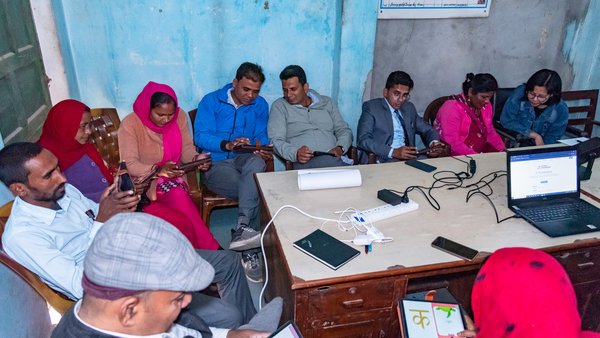
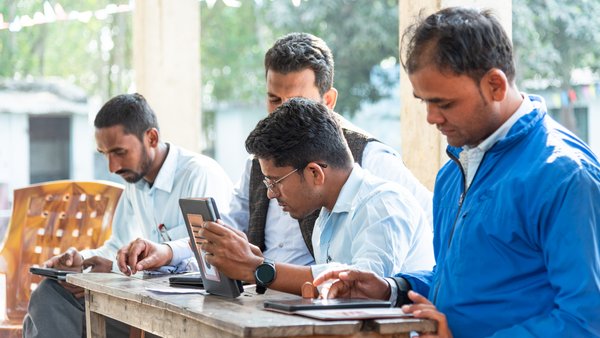
In both schools, we engaged students from ECD to Grade 3 through drawing exercises and the use of E-Paath and HRK videos on tablets to familiarize them with the learning materials. The drawing activities focused on the alphabets and prompts were also provided, encouraging students to create artwork based on the questions such as: "What do you like to do when you go home? What are your hobbies?" Students incorporated culturally relevant motifs such as flowers, trees, and houses. Language barriers posed a challenge for younger students, however teachers assisted in translating instructions to Maithili language and managing the classroom to ensure understanding. Usability issues with the E-Paath, such as students switching chapters without completing them and difficulties navigating the interface, revealed the need for a more intuitive learning experience. These insights have been helpful in guiding us to improve the user interface and navigation in upcoming learning materials to better support student engagement and learning outcomes.
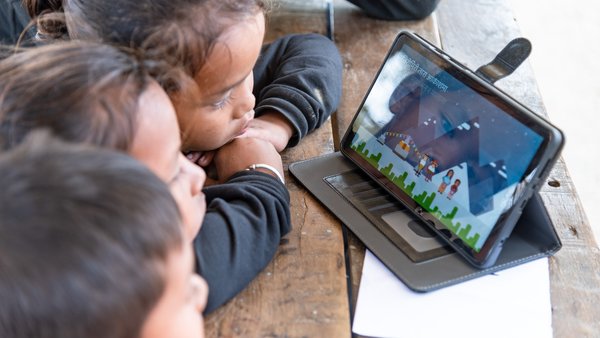
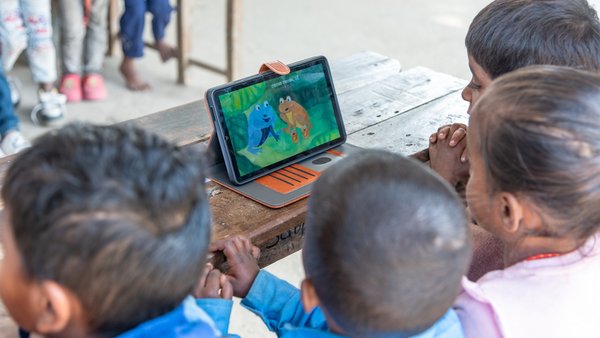
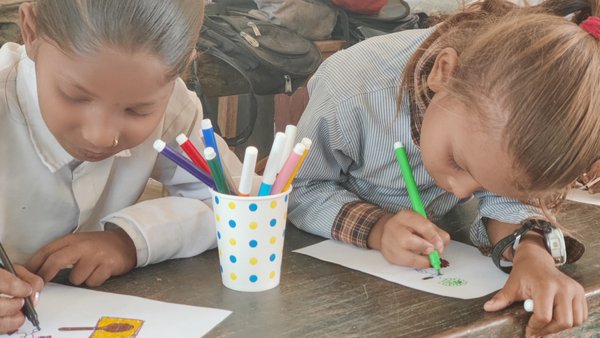
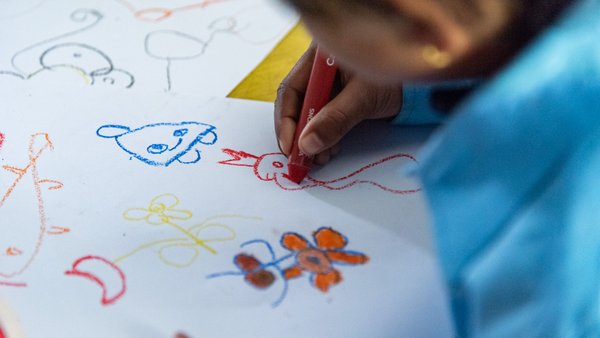
At both schools, we conducted workshops with Grade 4 and 5 students to better understand their learning needs, engage them in group activities, critical thinking, and introduce them to digital learning materials. For Grade 4, we organized a story-building activity where students worked in groups to create drawings and craft stories around them. The students showed enthusiasm for expressing their ideas through art and storytelling. The activity was designed to encourage creativity and enhance their confidence in collaborative work. Afterward, students explored E-Paath, E-Pustakalaya, and HRK videos. While some students engaged with the E-Paath and HRK videos, others were drawn toward the storybooks in E-Pustakalaya, preferring reading activities. For Grade 5, we facilitated a science activity where students created imaginary creatures, encouraging them to think critically about animal habitats and diets. This hands-on approach encouraged critical thinking about scientific concepts. Overall, the workshops proved to be an effective blend of art, critical thinking, and digital learning, offering an educational experience.
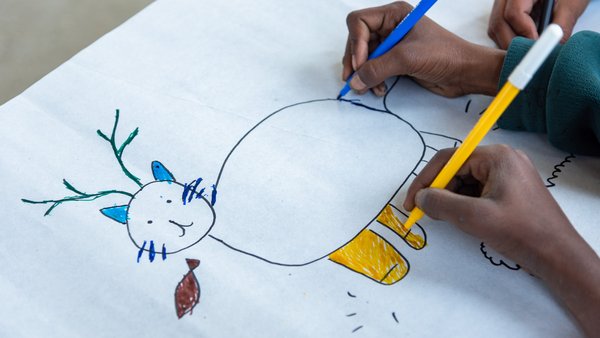
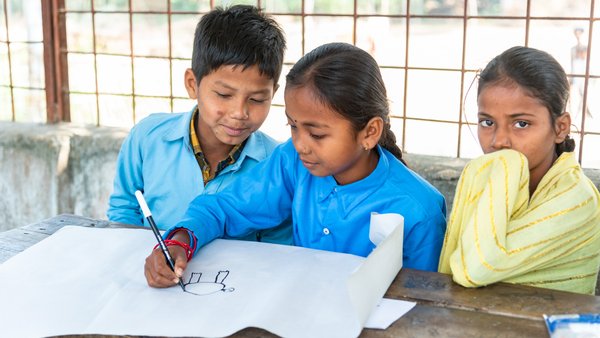
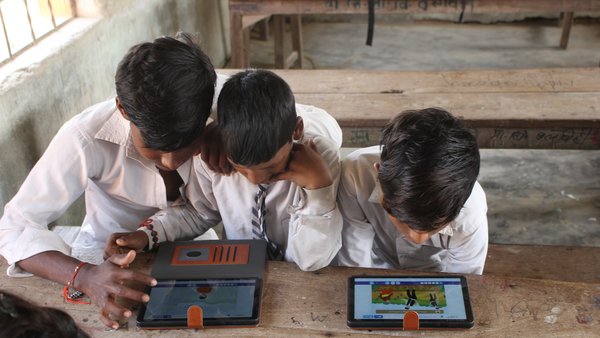
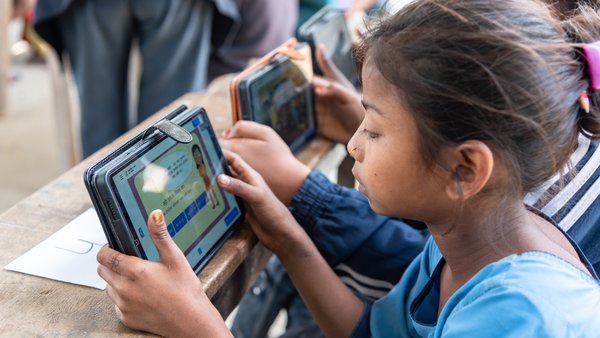
The Grade 6-7 activities at both schools engaged students in creative exercises, hands-on tasks, and problem-solving challenges. In the comic strip activity, students addressed pressing social issues such as waste management, health crises, lack of schools, and animal attacks. Through group work, they proposed solutions like improving waste disposal, using herbal remedies for health, expanding school infrastructure, and protecting crops with fences. This activity stimulated critical thinking and also helped students connect with their local environment. Following this, they explored digital learning tools such as E-Paath and HRK videos, which were intended to enhance their engagement with technology. Grade 7 students further applied their critical thinking and estimation skills by tackling Fermi problems, such as estimating the number of leaves in a mango tree. They also worked on mathematics problem-solving, using E-Paath lessons to estimate perimeter and area, reinforcing key math concepts.
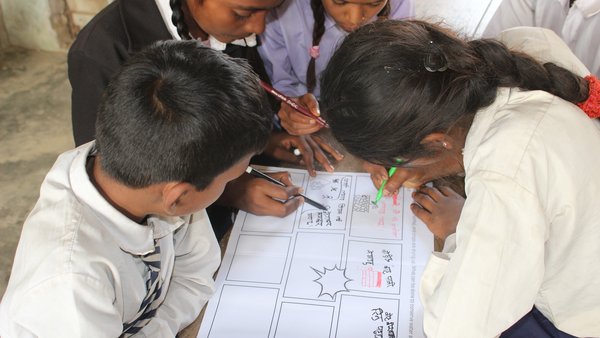
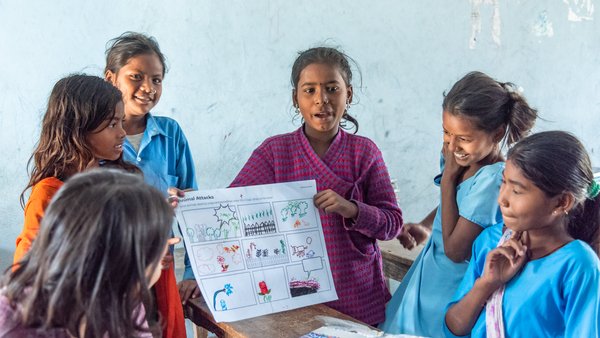
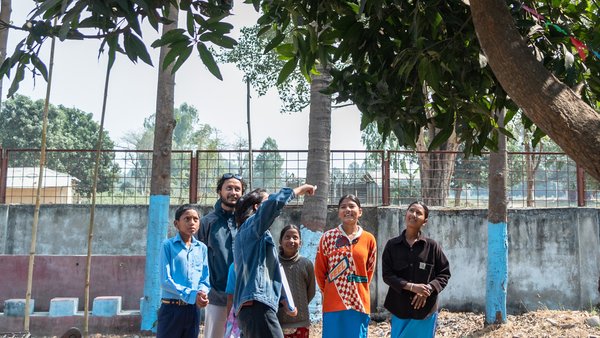
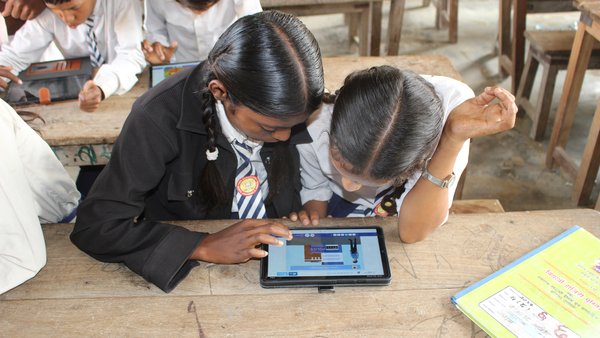
The activities conducted with Grade 8 students focused on exploring skills, creative thinking, and the use of digital learning tools. The workshops included various hands-on activities, such as skill exploration, character-building, and story creation, which encouraged students to think creatively. During the character drawing activity, students collaboratively designed characters, linking each to specific skills they had learned about, which helped them understand how skills can influence actions and decision-making. By developing and presenting their characters and stories, students shared their ideas in groups.
The FGDs conducted with the students provided insights on their educational goals, their aspirations, and the role of technology in shaping their learning journeys. Many students expressed a strong enthusiasm for using technology, particularly video streaming platforms and using search engines to supplement their education, though some students mentioned challenges due to limited internet access. This feedback highlighted the need for broader access to digital resources to better support their learning.
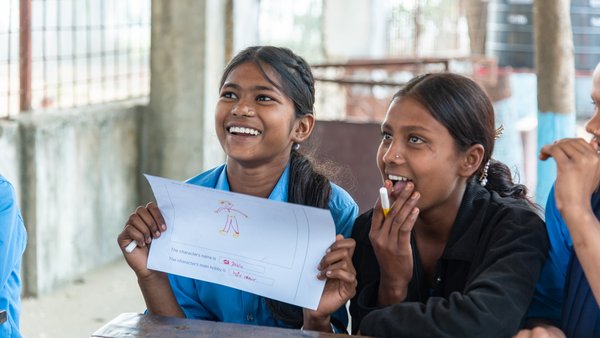
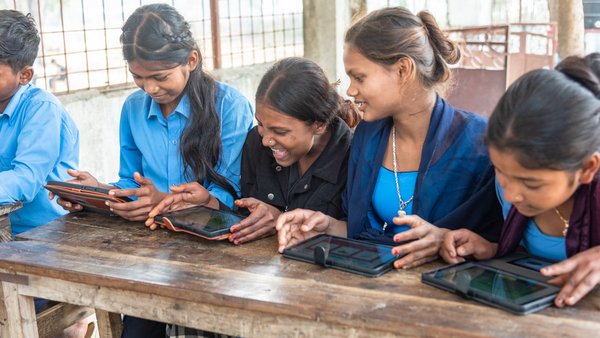
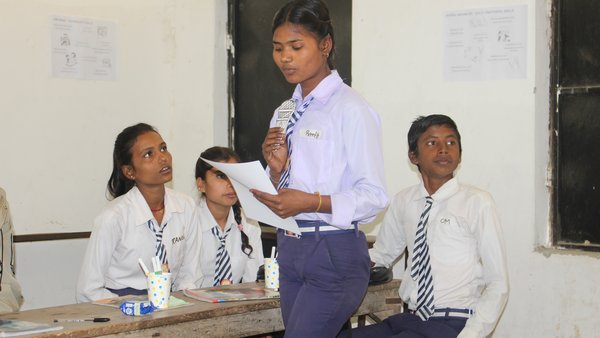
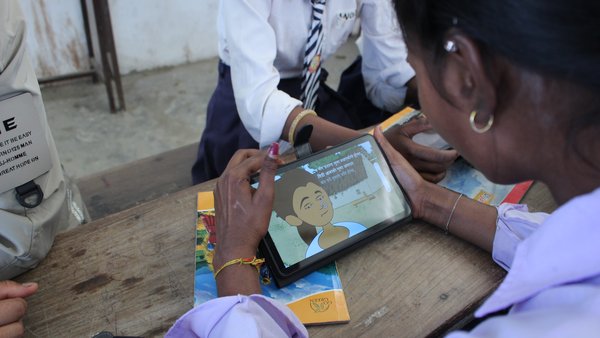
In addition to these activities, the tablet-based tech demos were particularly effective in familiarizing students with digital learning platforms like E-Paath and HRK. These demonstrations gave students the opportunity to interact with technology and understand how it can be used to enhance their educational experiences, making them aware about digital tools for learning.
The workshops and tech demonstrations for Grades 9 and 10 were held at Shree Madhyamik Vidyalaya in Janakpurdham. These activities engaged 13 students in a series of skill exploration and technology demonstrations. Students participated in icebreakers, skill chart explorations, and self-assessments where they identified their strengths and aspirational skills. The workshop also included group discussions on how to develop skills such as English language, computer, and teaching skills. Following the workshop, students explored digital learning resources on tablets. Students appreciated the opportunity for self-reflection and the chance to explore new skills.
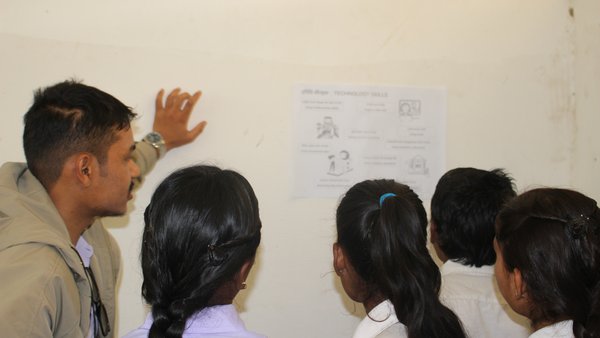
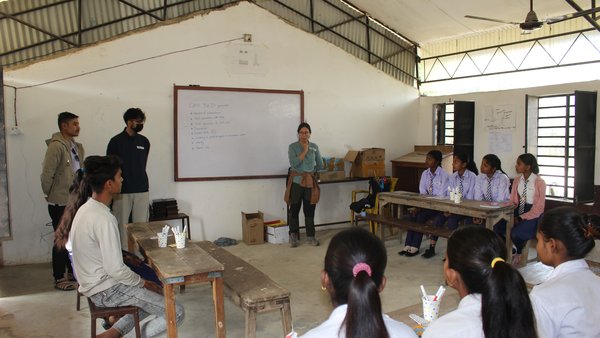
To assess students' foundational learning skills, we conducted surveys in both the schools, covering students from Grades 2 through 8. A total of 98 students in Shree Janta Adharbhut Vidhyalaya in Dhangadhimai and 96 in Shree Madhyamik Vidyalaya, Janakpurdham participated, with surveys carried out over multiple days by team members. While these assessments provided valuable insights, challenges such as language barriers, particularly with younger students, were observed. The findings indicate significant gaps in both literacy and numeracy. In Shree Janta Adharbhut Vidhyalaya, only about 12% of students demonstrated foundational numeracy skills, while English reading proficiency was alarmingly low, with just one student successfully completing the reading tasks and only 11% able to read a simple short story at a Grade 2/3 level. In Shree Madhyamik Vidyalaya, Janakpurdham, while students performed slightly better in numeracy (with just over 21% demonstrating foundational skills), reading proficiency remained low where only 15% exhibited basic Nepali reading skills, and no student was able to complete the English reading tasks. These results highlight a pressing need for targeted interventions focusing on foundational literacy and numeracy, which are critical for students' overall learning progression. Through this survey, we learnt that addressing these gaps through tailored digital learning content, and additional support mechanisms will be essential in strengthening students' academic foundations. So, our course development efforts have been strategically aligned to bridge these learning gaps and enhance foundational skills.
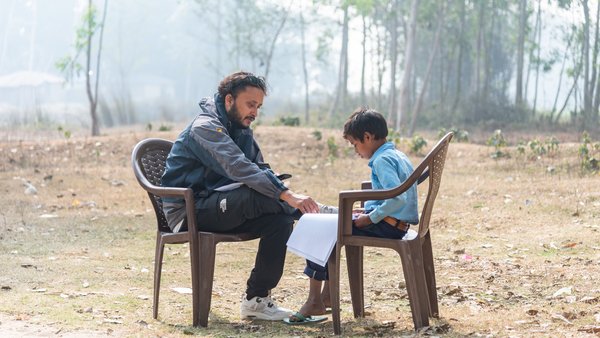
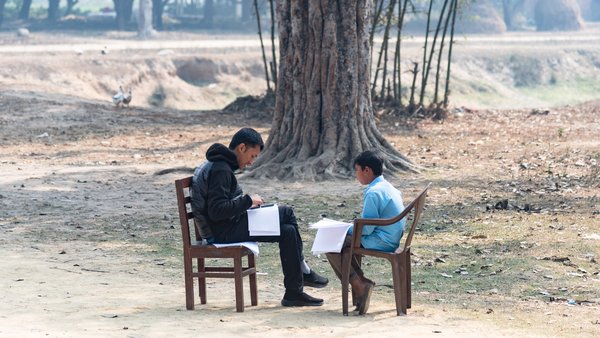
These field visits represented a meaningful step forward in advancing education through technology under the ONGD-LLEST Project. Through orientation sessions, hands-on training sessions, student and teacher workshops and surveys, and conversations with teachers and community members, we gained a better understanding of the local educational context and the learning needs of students and teachers. These interactions allowed us to evaluate the relevance of our digital learning platforms while laying the groundwork for long-term collaboration with school stakeholders. With ongoing support and community engagement, we believe we can enhance both the quality and accessibility of education in these schools.
We sincerely thank our partner ONGD-FNEL for their support throughout this initiative. Our appreciation also goes to the school administrators, teachers, students, parents, and School Management Committees at Shree Madhyamik Vidyalaya and Shree Janata Basic School for their hospitality and active participation. We are equally grateful to the representatives of Janakpurdham Sub-Metropolitan City and Dhangadhimai Municipality for their cooperation and commitment to promoting the quality of education.
View more photos from our visits to Shree Madhyamik Vidyalaya, Janakpurdham-22, Basabitti and Shree Janta Adharbhut Vidhyalaya, Dhangadhimai-4, Shantanagar.